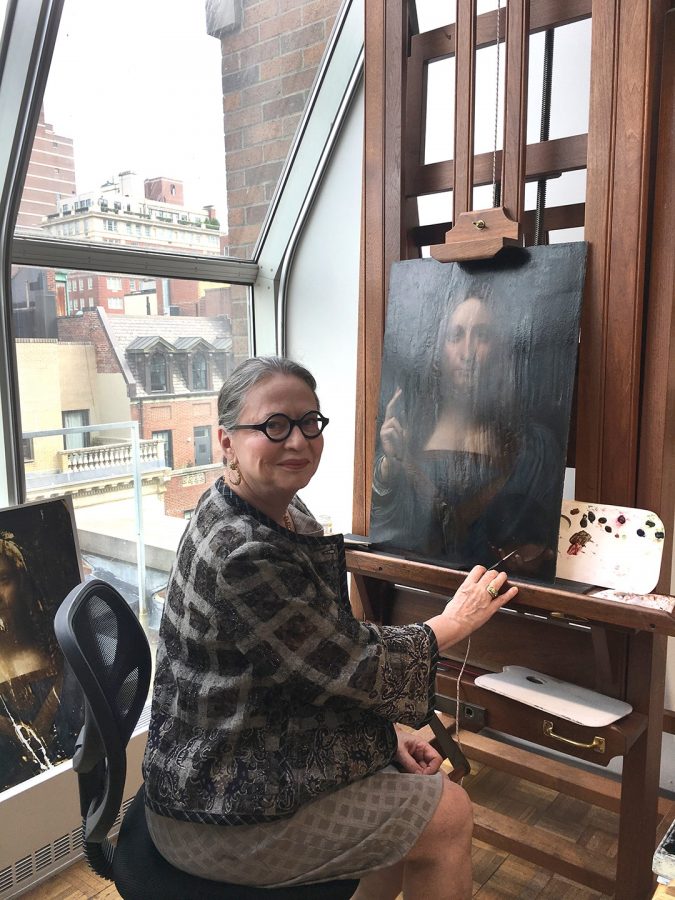Conservator of Da Vinci’s Salvator Mundi tells story of how she found world’s most expensive painting
March 8, 2018
Dianne Modestini spoke in the Gallery Forum of the Elaine Langone Center the evening of March 1 as part of the Samek Distinguished Lecture Series. Modestini is an art conservator who cleaned, restored, and preserved Leonardo da Vinci’s “Salvator Mundi.” The work, which was identified and authenticated by Modestini after years of restoration, was sold in November of 2017 as the cornerstone of the Abu Dhabi’s new Louvre. The “Salvator Mundi” was purchased for $450 million, making it the world’s most expensive painting.
During her talk, Modestini discussed her 10-year restoration process of the masterpiece, as well as her work with the University’s Samek Kress Collection. Modestini is a Conservation Consultant to The Samuel H. Kress Foundation and Senior Research Fellow and Paintings Conservator for the Samuel H. Kress Program. In addition to speaking, she completed conservation treatments on works of the Samek’s Kress Collection. Patrons of the Samek Museum, Ed and Marty Samek, introduced Modestini to the crowd, calling the opportunity to hear her speak “truly remarkable.”
The “Salvator Mundi” is currently approximated to have been painted by da Vinci circa 1500. Although the work resurfaced and vanished many times throughout history, Modestini explained, it was known to exist due to various copies created by artists over centuries. Additionally, sketches of the work by da Vinci himself existed, including one in Windsor Castle.
In 2005, an art collector, friend, and colleague of Modestini and her late husband, Mario, who was also a conservator, called Modestini and asked if the couple would be able to look at a piece he had just purchased at an estate sale.
“He said he thought it could be something,” Modestini said. “He had very good eyes, as it turns out.”
Upon first studying the painting, Modestini found several damages due to failed conservation and/or cleaning efforts.
“The face was grotesquely repainted, and the curls on the proper right of his face had also been repainted,” Modestini said. Additionally, parts of the dark background “had been brutally scraped off.” However, she explained how pieces of the original masterpiece were still visible, pointing to the projection of the painting’s state prior to her restoration in the Gallery Forum.
“As you can see, the blessing hand was perfectly preserved, these curls on the left were perfectly preserved and the rest of the work was not repainted. And everyone missed this picture,” Modestini said.
After three years of working to remove damages and restore the painting, Modestini “came to believe 100 percent that this painting was by Leonardo and it could not be by anyone else because of the technique.” Her restorations included removing an added layer of brown paint over the original black background and restoring the damaged areas. Since 2008, this identification has been widely agreed upon by art historians and experts.
Additionally, Modestini discussed the use of science and technology in painting restoration and identification.While the attribution of the painting was supported through recently developed techniques such as X-ray and infrared imaging, Modestini stated: “You can’t authenticate your paintings with science. You can prove that it is fake but in the end, it all comes down to old-fashioned connoisseurship and judging if the painting is by the artist through the style and trying to recognize the artist’s hand.”
While her restoration of the painting has been widely praised, Modestini admits she “cringes a little” every time she looks at the work. She explained her belief that if a conservator does not do this when looking at work they have restored, “you are not a good restorer. You need the humility to always pay attention to the artist. I tried not to impinge on the original.”
Modestini concluded her talk by commenting on the artwork’s record breaking price, simply asking “What is the price of an artwork? How can we value art?” As the work is now highly valued, it therefore is not likely to be lost again. Modestini stated that she is grateful the work will now, “be available for scholars to see and students to continue to study because I think there is a great more to be learned here.”
“I think it was fascinating learning about how the value of the painting lays in its history; it’s had a complicated past! I think the Samek Museum’s decision to invite Mrs. Modestini was perfect considering how much press the ‘Salvator Mundi’ has recently received,” Grayson Kennedy ’19, member of the Samek’s Gallery Engagement Team.























Edward Joseph Hanemann • Jan 29, 2025 at 10:58 am
As one who knows nothing of Mr. Davinci’s work or style, the painting has a beauty, sense of grace & presence of it’s own. I have no idea of the truth of it’s origins, I only know it is a fascinating work of art. I hope it will be publicly viewed every now & then so that the world might enjoy this wondrous work.
Haze • Mar 31, 2022 at 11:22 pm
The moment she noticed the stroke of DaVinci, is the moment it became real. The moment she declared, “It is Leonardo”, is the moment it became Art. I too, have a painting from New Orleans. It is called “Shipwreck” Everything is strewn across the beach.
New Orleans is the Provenance for the Painting. Many ships came in and out. It is the one city, that could contain a lost painting.
She declared it. She did restoration. She followed the lines. She followed the images.